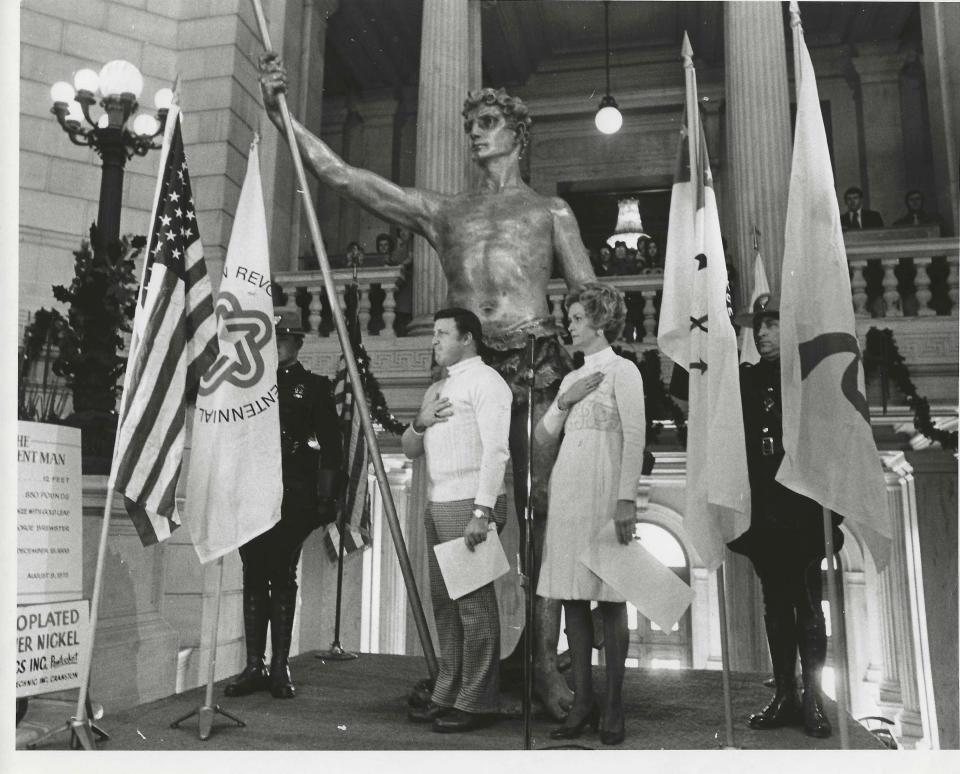Descent of the Independent Man in 1975 not without controversy | Opinion
Patrick T. Conley, historian laureate of Rhode Island, also was chairman of the Rhode Island Statehood Bicentennial Observance in 1990.
The nationally divisive controversy over statues and monuments, here in Rhode Island over Christopher Columbus and Commodore Esek Hopkins, has forced me to confess that I took down Rhode Island’s most famous monument — the Independent Man (with help, of course).
Back in the mid-1970s, I was the volunteer chairman of the Rhode Island Bicentennial of Independence Commission (ri76). Bill Dugan, the state property director, came to me with a proposal to re-gild the Independent Man, the Gorham-built statue that had stood stoically atop the State House dome for three-quarters of a century.
To undertake the project, he requested a grant from the commission. Unfortunately, the state did not fund ri76 adequately, so grant money was scarce. Fortunately, I agreed with Dugan that such a project could provide a great public spectacle.
Because of our limited budget, many members of my commission were reluctant to fund the project. After some debate and much urging by me, we voted by a show of hands. The result was an 11-to-11 tie. Then, as chairman, I voted “aye” to break the tie, and the Independent Man project soon became an attention-riveting success.

To orchestrate the project, I recruited my South Providence friend Marty Byrne, head of the Ironworkers Union, Local 37. His skilled laborers volunteered their services to remove the Man on Aug. 9, 1975, and then transport him to the Paul King Foundry in Johnston for repair and refurbishment.
As the refurbishing neared completion, Lloyd Bliss, the enterprising owner of Warwick Mall, suggested that we give Rhode Islanders an up-close look at the statue by putting it on display at his mall. My commission accepted the offer and devised a way that ri76 could recoup some of its funds by charging people to have their picture taken with the Man. Hundreds took advantage of this opportunity and thousands more came to view him.
This project inspired Klitzner Industries of Providence to craft Independent Man medallions and miniature statuettes. Rhode Islanders bought thousands of these souvenirs, raising money for our state’s celebration of independence. Today, these statuettes are presented to current inductees into the Rhode Island Heritage Hall of Fame.
More: Politics? TV? Once he's brought from his perch, what will the Independent Man do next?
Unfortunately, no good deed goes unpunished. Owners of other malls and shopping centers complained that the state had given Warwick Mall an unfair trade advantage by creating such an attraction, and they brought suit to enjoin the display.
That successful legal challenge cut short the Man’s mall visit. He was removed to the State House rotunda for display and was later installed, with some difficulty, to his lofty perch on July 20, 1976, via helicopter. The Man’s ascension was marked by a ceremony presided over by Gov. Phil Noel, Adjutant Gen. Leonard Holland and me.
Since July 1976, the Independent Man has stood like a sentinel over our seat of government. He symbolizes the spirit of independence and innovation that made Rhode Island an American leader in the development of religious liberty, democracy, federalism, the establishment of our nationhood, and the creation of our industrial economy. Thankfully he stands high enough, at 235 feet, so that anyone desiring to remove him can only do it with great difficulty.
However, Time, which allegedly heals all wounds, has now wounded the footing of the Independent Man, necessitating another take-down. I hope this descent and repair will be as successful as that of 1976, and that the Man’s return to his stately perch will become a focal point of the upcoming 250th anniversary of independence in 2026, as it was for ri76.
This article originally appeared on The Providence Journal: Since July 1976, the Independent Man has stood like a sentinel over our seat of government.

